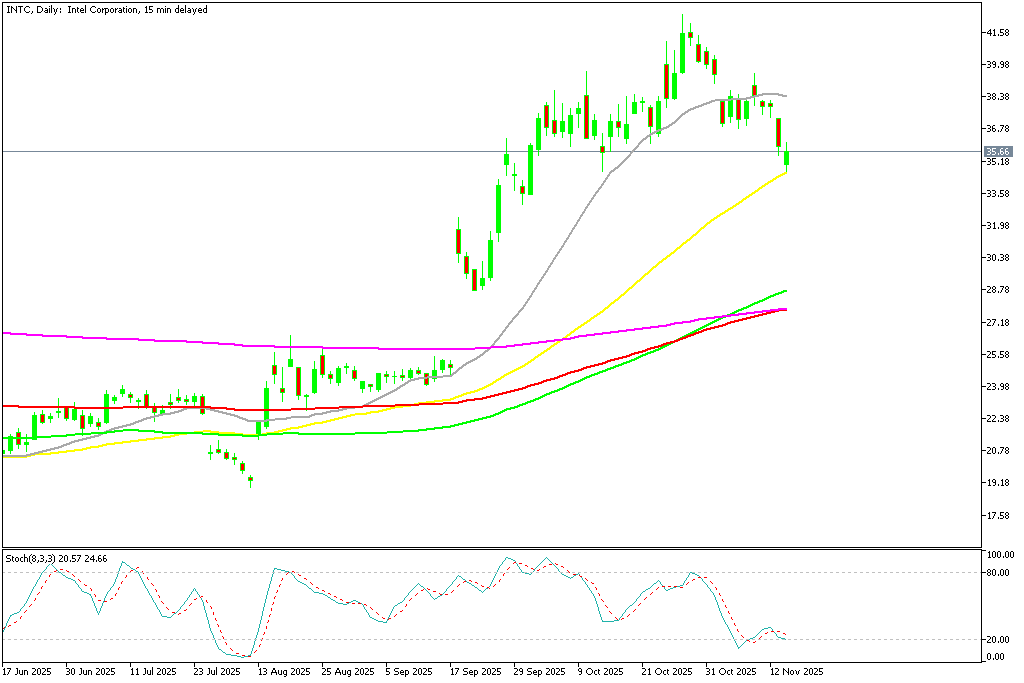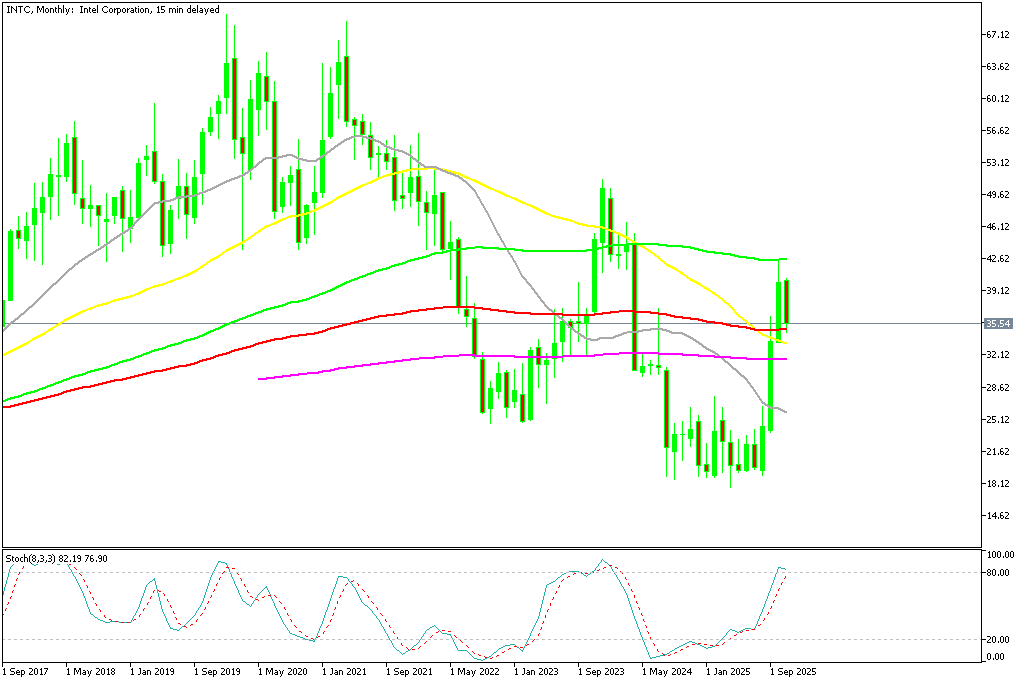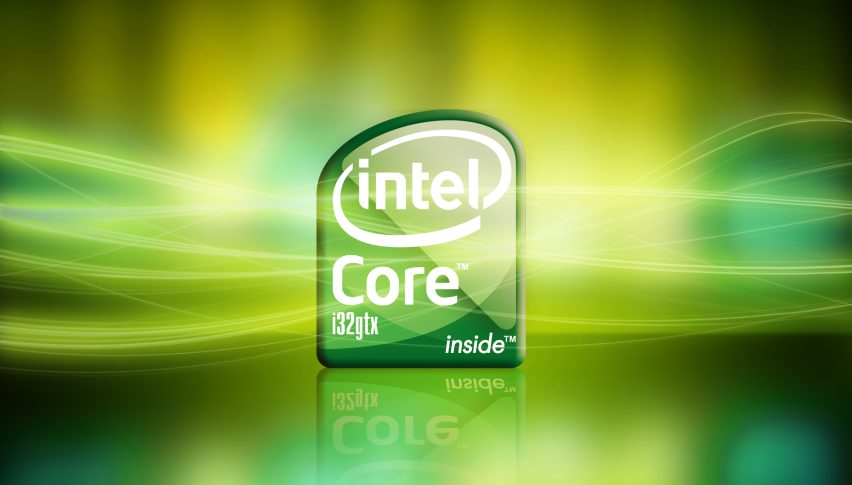Intel Stock Rebounds at Support From Selloff, AMD Can’t Win the Race, as Vision Remains Intact
Intel shares rebounded from a steep mid-week selloff, stabilizing on strong policy backing and strategic leadership shifts, while AMD faces

Quick overview
- Intel shares rebounded from a mid-week selloff, stabilizing due to strong policy support and leadership changes.
- Despite recent volatility, investor confidence in Intel's turnaround remains strong, with a focus on AI innovation.
- AMD faces increasing pressure as its market position weakens amid tightening margins and cooling enthusiasm for its AI strategy.
- Strategic partnerships with major tech firms are enhancing Intel's competitive edge, while AMD's reliance on external manufacturing exposes it to greater risks.
Live INTC Chart
[[INTC-graph]]Intel shares rebounded from a steep mid-week selloff, stabilizing on strong policy backing and strategic leadership shifts, while AMD faces intensifying pressure amid slowing momentum and fragile demand.
Early-Week Volatility Gives Way to Renewed Stability
After one of its most impressive multi-month rallies in years, Intel (NASDAQ: INTC) encountered turbulence this week as broader markets sank under hawkish Federal Reserve remarks and shifting risk appetite. The stock slid sharply on Thursday and briefly broke below $35 early Friday, pressured partly by headlines surrounding OpenAI’s procurement decisions and renewed debates about AI market expectations.
However, the downside was met with notable buying interest. Intel quickly recovered, reclaiming the $36 level by Friday afternoon as traders viewed the selloff as an opportunity rather than a trend reversal. The swift rebound demonstrated that investor confidence in Intel’s turnaround—while challenged—remains fundamentally strong.
Market Sentiment Tests – The 50 Daily SMA Holds
Intel’s recent climb to $42.50 — its highest level in more than a year — showcased a powerful resurgence fueled by policy support, improving execution, and strengthening investor sentiment. But the rally stalled at a critical technical ceiling, triggering a healthy correction as the stock retreated roughly 5% on Thursday.
Much of the volatility centered around reports that OpenAI excluded Intel chips from its multi-billion-dollar AI hardware plans. While the headlines triggered an emotional knee-jerk reaction, they do not reflect the broader momentum Intel is building across datacenter, manufacturing, and AI infrastructure. In fact, leadership shifts suggest Intel is doubling down on innovation rather than retreating from it.
Meanwhile, AMD — often touted as Intel’s closest competitor — is showing signs of strain. Although AMD’s shipments exceeded Intel’s in Q3 2025 versus the prior year, analysts warn that the company may be approaching its peak cycle. Margins are tightening, supply constraints are resurfacing, and enthusiasm around its AI positioning is cooling as expectations collide with execution challenges.
Intel, despite the temporary setback, appears far more strategically aligned with long-term U.S. manufacturing priorities and technology leadership.
Leadership Refresh Reinforces Strategic Commitment
Intel confirmed on November 10 that CEO Lip-Bu Tan would personally oversee the Chip and Advanced Technologies Groups following the departure of CTO Sachin Katti to OpenAI. Rather than destabilizing the company, the shift was interpreted as a direct signal that Intel’s top leadership is now even more committed to accelerating AI innovation internally.
This renewed focus comes as Intel continues benefiting from unprecedented U.S. policy support. Under the CHIPS Act, Intel has secured nearly $16 billion in combined funding and loan guarantees, cementing Washington’s intention to restore domestic semiconductor manufacturing leadership. This backing has fueled a dramatic recovery — Intel shares have more than doubled since their August lows near $19.
AMD, by contrast, faces the headwinds of increasing scrutiny, waning investor enthusiasm, and rising competitive pressure from both Intel and Nvidia. While AMD captured temporary market share, its longer-term positioning now looks less certain as Intel ramps U.S. production and Nvidia dominates the AI landscape.
Technical Setup Still Favors Intel’s Longer-Term Outlook
Intel’s rally hit resistance at the 100-month simple moving average (SMA) near $42.50 — a formidable technical barrier. The rejection pulled shares back toward the $34.50 support region, aligning with the 200-SMA on the monthly chart and the 50-SMA on the daily chart. These overlapping levels create a strong technical floor that has already attracted dip buyers.
INTC Monthly Chart – The 100 SMA Rejected Earlier
Should downside pressure return, analysts expect the $30–$32 zone to act as the next major accumulation area. A rebound from this region would likely re-ignite bullish momentum. A sustained break above $42.50 remains a key target for long-term bulls.
Strategic Partnerships Strengthen Intel’s Position Against Competitors
Despite recent headwinds, Intel continues to attract interest from major global technology firms. Industry reports indicate that Apple, SoftBank, Nvidia, and others are exploring deeper partnerships with Intel to secure supply chains and co-develop next-gen chip technologies.
These potential alliances highlight the industry’s growing recognition that Intel’s U.S.-based manufacturing capacity — combined with its IDM 2.0 strategy — is becoming essential for long-term stability. AMD, which relies heavily on external manufacturing, remains more exposed to global supply-chain disruptions and competitive pricing pressure.
- Check out our free forex signals
- Follow the top economic events on FX Leaders economic calendar
- Trade better, discover more Forex Trading Strategies
- Open a FREE Trading Account




